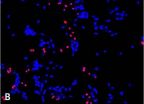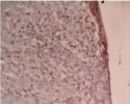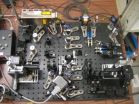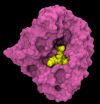(Press-News.org) Changing the texture and surface characteristics of a semiconductor material at the nanoscale can influence the way that neural cells grow on the material.
The finding stems from a study performed by researchers at North Carolina State University, the University of North Carolina at Chapel Hill and Purdue University, and may have utility for developing future neural implants.
"We wanted to know how a material's texture and structure can influence cell adhesion and differentiation," says Lauren Bain, lead author of a paper describing the work and a Ph.D. student in the joint biomedical engineering program at NC State and UNC-Chapel Hill. "Basically, we wanted to know if changing the physical characteristics on the surface of a semiconductor could make it easier for an implant to be integrated into neural tissue – or soft tissue generally."
The researchers worked with gallium nitride (GaN), because it is one of the most promising semiconductor materials for use in biomedical applications. They also worked with PC12 cells, which are model cells used to mimic the behavior of neurons in lab experiments.
In the study, the researchers grew PC12 cells on GaN squares with four different surface characteristics: some squares were smooth; some had parallel grooves (resembling an irregular corduroy pattern); some were randomly textured (resembling a nanoscale mountain range); and some were covered with nanowires (resembling a nanoscale bed of nails).
Very few PC12 cells adhered to the smooth surface. And those that did adhere grew normally, forming long, narrow extensions. More PC12 cells adhered to the squares with parallel grooves, and these cells also grew normally.
About the same number of PC12 cells adhered to the randomly textured squares as adhered to the parallel grooves. However, these cells did not grow normally. Instead of forming narrow extensions, the cells flattened and spread across the GaN surface in all directions.
More PC12 cells adhered to the nanowire squares than to any of the other surfaces, but only 50 percent of the cells grew normally. The other 50 percent spread in all directions, like the cells on the randomly textured surfaces.
"This tells us that the actual shape of the surface characteristics influences the behavior of the cells," Bain says. "It's a non-chemical way of influencing the interaction between the material and the body. That's something we can explore as we continue working to develop new biomedical technologies."
INFORMATION:
The paper, "Surface Topography and Chemistry Shape Cellular Behavior on Wide Band-Gap Semiconductors," is published in Acta Biomaterialia. Senior author of the paper is Dr. Albena Ivanisevic, an associate professor of materials science and engineering at NC State and associate professor of the joint biomedical engineering program at NC State and UNC-Chapel Hill. The paper's co-authors include Dr. Ramon Collazo, an assistant professor of materials science and engineering at NC State; Shu-han Hsu and Nicole Pfiester Latham, Ph.D. students at Purdue University; and Dr. Michael Manfra of Purdue University.
Surface characteristics influence cellular growth on semiconductor material
2014-03-12
ELSE PRESS RELEASES FROM THIS DATE:
Alpha-synuclein effects on dopaminergic neurons: Protection or damage?
2014-03-12
Alpha-synuclein is a principal component of Lewy bodies and Lewy neurites, which are pathologic hall-marks of Parkinson's disease. Alpha-synuclein is generally considered to play a role in synaptic activity, although its function remains largely unknown. Accumulative evidence has been shown that aggregated extracellular alpha-synuclein fibrils can be internalized in the cells and enhance the intracellular formation of protein inclusions, leading to cell death. Conversely, there is emerging evidence suggesting that alpha-synuclein has also neuroprotective effects. In one ...
PD-L1: A potential treatment target for multiple sclerosis
2014-03-12
Experimental allergic encephalomyelitis is a mouse model of human multiple sclerosis with similar pathology and pathogenesis. Th1 cells play an important role in the pathogenesis of experimental allergic encephalomyelitis. Therefore, Qun Xue, Fanli Dong and co-workers from the First Affiliated Hospital of Soochow University in China speculated that programmed cell death 1 ligand 1 (PD-L1) plays an important role in the pathogenesis of multiple sclerosis. A recent study by these researchers published in the Neural Regeneration Research (Vol. 8, No. 35, 2013) found that the ...
Quantum physics secures new cryptography scheme
2014-03-12
The way we secure digital transactions could soon change. An international team has demonstrated a form of quantum cryptography that can protect people doing business with others they may not know or trust – a situation encountered often on the internet and in everyday life, for example at a bank's ATM.
"Having quantum cryptography to hand is a realistic prospect, I think. I expect that quantum technologies will gradually become integrated with existing devices such as smartphones, allowing us to do things like identify ourselves securely or generate encryption keys," ...
Peripheral nerve regeneration using a nerve growth factor-containing fibrin glue membrane
2014-03-12
Complete regeneration is usually very difficult following peripheral nerve damage, though microsurgical techniques have vastly increased the success rate of surgery to repair the injured nerve. This occurs possibly because of a lack of neurotrophic factors and extracellular matrix in the injured region, which results in a microenvironment that is not optimal for peripheral nerve regeneration. Nerve growth factor (NGF) was the first neurotrophic factor identified in a class of molecules responsible for neuronal survival and differentiation. Consequently, many techniques, ...
Iron overload is a risk factor for diabetic peripheral neuropathy
2014-03-12
Iron overload can lead to cytotoxicity, and it is a risk factor for diabetic peripheral neuropathy. However, the underlying mechanism remains unclear. Prof. Shi Zhao and team conjectured that iron overload-induced neurotoxicity might be associated with oxidative stress and the NF-E2-related factor 2 (Nrf2)/ARE signaling pathway. As an in vitro cellular model of diabetic peripheral neuropathy, PC12 cells exposed to high glucose concentration were used in this study. PC12 cells were cultured with ferric ammonium citrate at different concentrations to create iron overload. ...
Parasites in humans influence each other via shared food sources
2014-03-12
Over 1,400 species of parasites – viruses, bacteria, fungi, intestinal worms and protozoa – are able to infect humans. In most cases, the right medicine against a parasite cures the patient. If he or she suffers from an infection by two or more species of parasite at the same time, however, it soon becomes more difficult to diagnose and treat. Medication can even exacerbate the medical condition if one pathogen is killed off but the second flourishes. One reason is the little-understood interactions between the parasites that reside in the same host.
In a study published ...
Genes bring music to your ears
2014-03-12
Multiple regions in the human genome are reported to be linked to musical aptitude, according to a study published this week in Molecular Psychiatry. The function of the candidate genes implicated in the study ranges from inner-ear development to auditory neurocognitive processes, suggesting that musical aptitude is affected by a combination of genes involved in the auditory pathway. The research was funded by the Academy of Finland.
The perception of music starts with specialised hair cells in the inner ear, which transmit sounds as electronic signals through the auditory ...
Discrepancies in clinical trial reporting raise questions of accuracy
2014-03-12
In a Yale School of Medicine analysis of 96 research trial results published in top journals, almost all had at least one discrepancy between what was reported on the public clinical trial registry clinicaltrials.gov and what was posted in the journal article.
"This study raises serious questions about the accuracy of results reporting in both clinical trial registries and publications, and the importance of consistent presentation of accurate results," said Joseph Ross, M.D., assistant professor of medicine and public health at Yale School of Medicine and senior author ...
Promoting love can punish sales
2014-03-12
Valentine's Day has come and gone. But those images of romance are still everywhere : a happy couple holding hands in an eharmony ad, two lovebirds sharing a tender kiss in a Nikon camera commercial.
Advertising filled with romantic images, featuring "happy togetherness" in magazines and stores as well as on television and websites might resonate with you if you have a special someone. But if you're single, a new study shows you're not buying.
New research from consumer psychologist Lisa Cavanaugh, assistant professor at the USC Marshall School of Business, reveals ...
A tailor-made molecule against malaria
2014-03-12
The malaria parasite is particularly pernicious since it is built to develop resistance to treatments. The lack of new therapeutic approaches also contributes to the persistence of this global scourge. A study led by Didier Picard, professor at the Faculty of Sciences of the University of Geneva (UNIGE), Switzerland, describes a new class of molecules targeting the two problems at the same time. Using ultra sophisticated computerised modelling tools, the researchers were successful in identifying a type of candidate molecules toxic for the pathogen, but not for the infected ...




